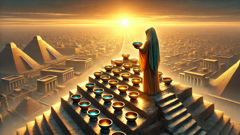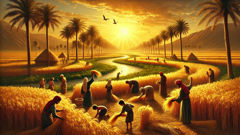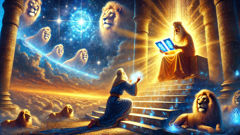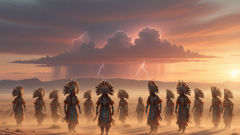Introduction
Across the cradle of civilization, between the slow, glistening arms of the Tigris and Euphrates, the ancient land of Mesopotamia breathed beneath the gaze of the sun. Every morning, as the horizon blushed gold, the people of Sumer, Akkad, and Babylon lifted their faces to greet Shamash—the radiant god who brought day from the shadows. Shamash was more than a celestial body to them; he was hope, a source of order and blessing. His journey across the sky told the oldest story: the struggle between chaos and harmony, ignorance and enlightenment. In a world still tangled with mystery and uncertainty, where river floods shaped fates and city walls rose from reeds and clay, Shamash was the steadfast presence promising clarity. He was the judge who saw all beneath his rays, whose golden chariot never faltered, who knew the secrets in the hearts of kings and the silent pleas of the humble. The Anush-era—named for the ancient word for “radiance” in the tongues of old—marked the time when Shamash’s gifts first poured into the world. It was said that the dawns then were brighter, the fields more fertile, and justice found its roots in every shadow his light dispelled. In temples of sun-dried brick, priests raised hymns that shimmered in the warm air, while artisans shaped tablets and heroes dreamed beneath the endless sky. Yet, beyond the songs and sacrifices, there was a deeper tale: how wisdom, life, and justice were woven into the very fabric of Mesopotamian existence. This is the story of how Shamash’s luminous journey became the heart of civilization—guiding, nurturing, and judging all who dwelled within his golden embrace.
The Dawn of Wisdom: Shamash’s Illumination
Before civilization took root, darkness blanketed the land each night, shrouding the world in uncertainty and fear. In the cool hours before dawn, the people of the ancient cities huddled close together, whispering prayers into the silence, their hopes tied to the coming sun. Each morning, as the first sliver of gold appeared over the horizon, children and elders alike felt awe and relief. The arrival of Shamash wasn’t just the return of light—it was the return of understanding, of the power to see and be seen.

In these earliest days, wisdom was scarce. The earth teemed with spirits and shadows, and humans struggled to decipher omens in the stars or whispers in the reeds. The priests of Eridu and Uruk, draped in linen dyed with earth pigments, watched the sunrise from temple terraces, their hearts heavy with questions. They wondered: Why do rivers flood? Why do the crops sometimes fail? How can justice be found amid confusion? Their minds reached for answers in the glow of dawn.
It was on one such morning that Shamash, seeing the yearning in their hearts, decided to gift humanity the first spark of wisdom. As his chariot wheeled high above the world, he gazed down and saw Enlil, the wind god, stirring the fields with breezes and Enki, god of water and wisdom, guiding the rivers. But it was Shamash’s illumination that allowed mortals to truly perceive the world’s patterns. Through his rays, he whispered understanding into the minds of those who watched and waited.
A legendary tale tells of Ninsun, a wise woman and priestess of Uruk, who rose early and climbed the steps of her city’s ziggurat. There, in the golden hush before the city awoke, she laid out seven bowls filled with water and reflected the sunrise in each. Shamash, pleased with her devotion, sent a shaft of light so bright it made the waters shimmer with hidden images: signs of the stars, the movement of fish in the river, the slow turning of seasons. Ninsun saw these things and understood how to read the world’s messages.
She taught her people to watch for the signs—when reeds bent in certain ways, when birds flew low before a storm, when the moon’s reflection wavered in the Tigris. With each revelation, a layer of ignorance was peeled away. The people learned to predict floods and prepare for droughts, to plant their barley by the cycle of the sun and not by blind chance. Shamash’s light made the invisible visible, turning mystery into knowledge.
Soon, wisdom spread beyond Uruk. In Nippur, scribes began to etch their discoveries onto clay tablets, baking them in the sun so they would last through the ages. The first schools arose, where boys and girls learned to write not only prayers but also records of the stars, lists of plants, and the rules of mathematics. Every morning, as Shamash’s rays lit their classrooms, they thanked him for opening their eyes to the world’s wonders.
This era of enlightenment became known as the Anush-era—the Time of Radiance. Families gathered at dawn to greet the sun, sharing proverbs and riddles as his light streamed through doorways. Even kings came to rely on wise counsel, seeking omens in the way light fell through their palace windows. Wisdom was now the shared inheritance of all who walked beneath Shamash’s gaze.
The Gift of Life: Sunlight and Fertility in Mesopotamia
With wisdom blossoming, the people of Mesopotamia soon realized that Shamash’s light did more than reveal secrets—it awakened life itself. The great rivers, Tigris and Euphrates, were lifelines through a harsh desert, but it was sunlight that coaxed green from brown, grain from dust. The dawns of the Anush-era became celebrations of fertility, where the world seemed to pulse with promise under the sun’s watchful eye.

In the city of Lagash, farmers knelt in rich silt, hands caked with earth, eyes squinting at the horizon. They knew that without Shamash’s warmth, seeds would sleep forever. The god’s journey across the sky marked the rhythm of their days: planting at sunrise, tending in the noon heat, and harvesting as dusk cooled the fields. Children played in the shade of date palms while elders sang hymns in gardens that bloomed against all odds.
One spring, a drought threatened the land. The rivers shrank, and anxiety weighed heavy on every heart. The high priestess of Lagash, Ereshkigal (not to be confused with her namesake in the underworld), climbed to a sun altar with her people, bearing garlands woven from dried reeds and wildflowers. She lifted her arms and pleaded with Shamash for mercy. As her words rose into the shimmering air, a sudden shaft of sunlight pierced the haze, bathing the assembly in warmth and hope. That night, gentle rains fell. The next morning, green shoots broke through the earth.
Farmers spoke of miracles—how fields that once lay cracked and barren now shimmered with life. They built sun dials to track the hours and began marking the solstices with festivals. Shamash became not only a god of law and wisdom but the very giver of breath and harvest. Statues were carved with rays fanning from his shoulders, and his image appeared on clay amulets hung in homes to ensure safe childbirth and healthy crops.
Legends grew around how Shamash gifted animals with strong offspring and watched over shepherds moving flocks through golden grasslands. In the marshes where reeds grew tall and dragonflies darted, children believed that every living creature was touched by the sun’s hand. Even wildflowers closing at dusk were said to whisper thanks to Shamash for their brief day in bloom.
The cycle of life became sacred—planting, growing, reaping, resting. Each season was a promise renewed, every dawn a reassurance that the world would continue. Families traced their roots back to ancient farmers who first felt Shamash’s warmth on their backs. Life in Mesopotamia thrived, woven tightly with gratitude and ritual for the sun god’s enduring gift.
The Birth of Justice: Shamash’s Judgement Seat
As wisdom spread and life flourished, a new challenge faced the people of Mesopotamia: how to live together in harmony. Cities grew tall and crowded, ruled by kings whose word shaped destinies. But where there were people, there were also disputes—over land, water, honor, and inheritance. Without fairness, even the richest harvests bred resentment; even the wisest knowledge led to strife.

In those days, it was said that Shamash sat each day upon a throne of lapis lazuli at the eastern gate of heaven, watching the world with clear and impartial eyes. He saw every quarrel and heard every plea. When night approached, he journeyed through the underworld to ensure no wrong went unpunished and no cry went unheard.
One famous legend tells of King Ur-Nammu, who ruled the city of Ur with ambition but struggled to keep peace among his people. One morning, as he meditated beneath a temple archway, a golden beam fell upon him—Shamash’s sign that justice was needed. That night, Ur-Nammu dreamed of climbing a staircase of light to the very seat of Shamash. There, surrounded by cosmic lions and stars, the sun god gave him three tablets inscribed with laws. Each tablet glowed with power: one for truth, one for mercy, one for order.
Awakening, Ur-Nammu gathered his scribes and judges and shared what he had seen. They wrote down the laws—clear rules that governed trade, marriage, inheritance, and even how a wronged neighbor should be compensated. The first courts were born. People marveled at the sense of fairness that now guided their lives; even the powerful were bound by rules that glowed with the sun’s authority.
Throughout the Anush-era, every dispute was judged “in the light of Shamash.” Carvings on palace walls showed the sun god handing rods and rings—the emblems of authority—to kings and magistrates. Priests would invoke his name at dawn, asking for clarity and balance. Even criminals could plead their case, trusting that Shamash’s gaze missed nothing.
Justice ceremonies became community events. On market days, people gathered in temple courtyards as judges listened to both sides of every story. It was believed that lying under Shamash’s watch would bring misfortune, so honesty grew as natural as breath. Children learned proverbs extolling fairness: “The sun sees all, the sun judges all.”
As time passed, tales spread of Shamash descending from his chariot at dusk to wander the streets in disguise, testing the hearts of his people. Some nights, a weary traveler found unexpected kindness; other times, a greedy merchant lost everything to mysterious misfortune. All knew that justice was not only a law but a living force—Shamash’s enduring legacy.
Conclusion
So it was that in the Anush-era, beneath the unyielding gaze of Shamash, Mesopotamia flourished. Wisdom became woven into daily life; fields thrived under the rhythm of sun and season; justice found its place at every crossroad and palace gate. The people knew they were never alone—every dawn reaffirmed the bond between the mortal and the divine. The legacy of Shamash endured long after ziggurats crumbled and empires faded. His story lived on in sun-dappled proverbs, in tablets sealed with law, and in every act of kindness or fairness exchanged beneath the open sky. To this day, when sunlight streams over the land once called Sumer or Babylon, it carries whispers of that ancient promise: that wisdom brings understanding, that life is sacred when nurtured by hope, and that justice—like the sun—should shine on all without favor or fear.













